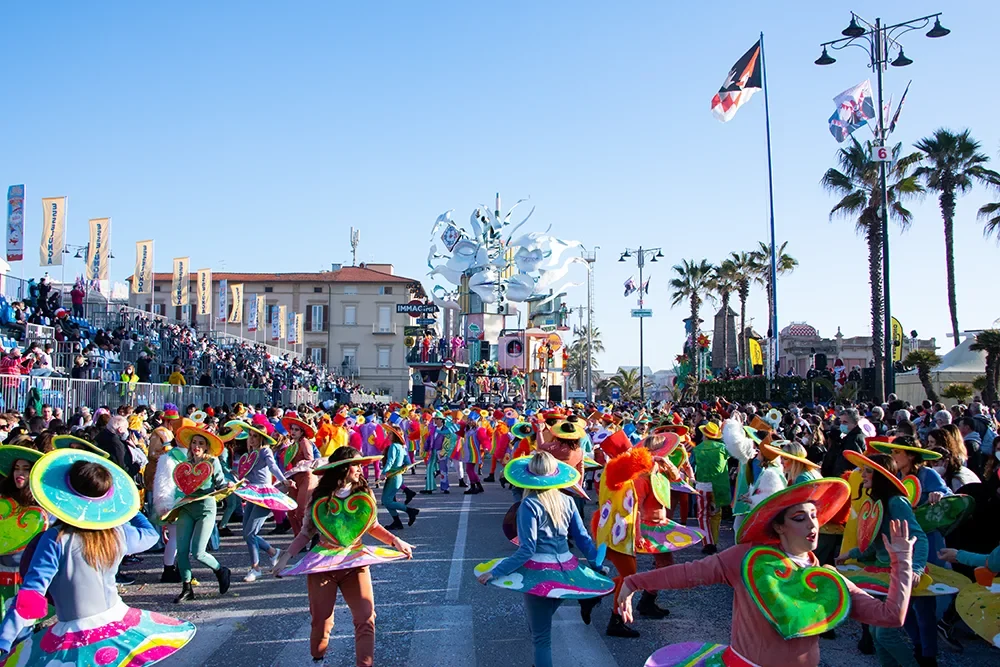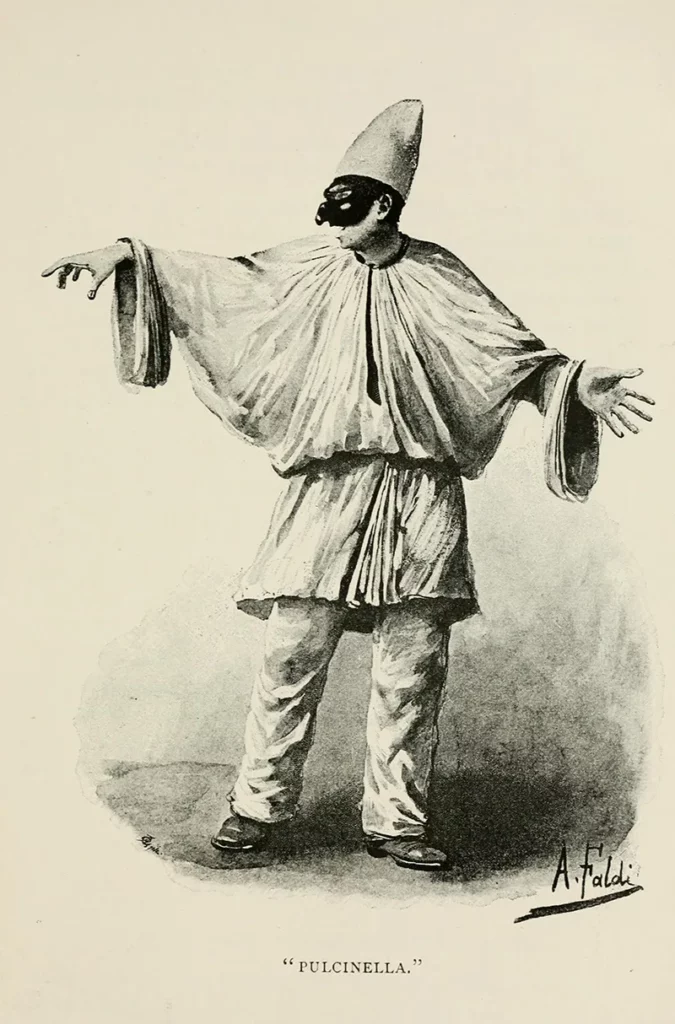- BY ISSIMO
- February 1, 2024

Costumes, floats, and fried sweets at the ready, dear friends! February is here…and Carnevale season is truly upon us. This is a joyous time of year when colour and confetti fill the air, when masks conceal mischief, and music fills the streets of cities and towns across Italy. A grand ‘last laugh’ before the Lent period begins in the lead up to Easter, Carnevale dates back to the 1200s, and continues to delight locals and curious visitors from all over the world with region-specific celebrations.
That’s right, it’s not just Venice in the spotlight during Carnevale season, despite the city turning on a world-famous kaleidoscope of traditional parades, performances and events every year. In fact, many towns and cities across the country have their own spin on the revelry. So, polish up those masks, fry up those dolci fritti, and join us as we embark on a whirlwind tour of Carnevale season across Italy.
Did you know the word ‘carnival’ (or ‘carnivale’ / ‘carnevale’ in Italian) is said to come from the Latin term ‘carnem levare’ which means to give up meat! So, the Carnevale period is an invitation to eat (indulge), drink, dance, and dress up before the traditionally solemn Lenten fasting period.
FIRST STOP: VENICE

Our tour kicks off in Venice, of course, the ‘grand dame’ and most famous of Italy’s Carnevale celebrations. From the end of January until the middle of February, Venice transforms into an immersive masquerade ball…as if it weren’t breathtaking enough already! Picture ornate gondolas gliding through canals transporting elaborately-costumed passengers, and picture masses of masked revellers parading around Piazza San Marco, dancing and singing under the gaze of ancient buildings. These sound like scenes from a dream, right?
While the history of the Venice Carnevale is a story unto itself, the event traces its ancient origins back to the year 1162 when the Republic of Venice claimed victory over its enemy. To celebrate this victory, Venetians dressed up and took to the streets, gathering in major public squares and piazzas (like Piazza San Marco, as they still do today) to sing and dance for days on end. The traditional festivities endured in full glory for centuries, before being banned by the Roman Emperor Francis II in 1797. Venice without Carnevale, huh? During the 19th century festivities were enjoyed privately in the absence of public parades and performances, and it wasn’t until 1979 that the event was officially reinstated by the government as Venetians reconnected with the vivacity of this event that has long been at the heart of their city’s cultural calendar.

Let’s face some facts about all those Venetian Carnevale masks, because they have deeper significance than just being decorative masterpieces. Masquerade masks are said to have first been worn around the streets of Venice for Carnevale in the 1260s, when people used them to artfully conceal their identities, and therefore, to conceal their social classes and status. They also allowed people to misbehave and indulge in improper behaviour without being caught!

Many designs for Venetian Carnevale masks are based on iconic characters from Commedia dell’Arte, including Columbina, Arlecchino, Pulcinella and Pierrot. You’ll no doubt stroll past countless shop windows in Venice packed from ceiling to floor with Carnevale masks that are still handmade by artisans as they have been for centuries. Keep an eye out for other mask styles too, including the ‘Volto’ full face mask (a ghost-like white wax mask with ornate detailing around the eye area) and the ‘Gatto’ mask, which is believed to reflect the historical scarcity of cats in the city of Venice during the Republic, which are, therefore, considered a prized creature to celebrated during Carnevale!

SECOND STOP: VERONA
If you’ve read ISSIMO’s Verona Travel Guide, you’ll know to prepare for a Carnevale experience with a special romantic touch. One of Italy’s oldest Carnevale dating back to the 1530s, the event fills Verona’s streets, piazzas and picturesque public meeting places with a flurry of colour, costumes, masks and music as part of its grand parade. It’s a sight to behold at least once in your lifetime!

While Archlecchino and Columbina might be king and queen of the Venice Carnevale, Papà de Gnocco is the hero of Verona’s festivities. Gnocco, as in Gnocchi? Correct! History tells us that Verona’s Carnevale originated during a time when there was a terrible food shortage in the region, and a wealthy nobleman from the city donated money for the city’s poor to buy flour to make gnocchi. The man ordered that these rations be given to the poor on the last Friday of every Carnevale period, and this is how Veronese Carnevale came to life.
It’s impossible to miss Papà de Gnocco, who is literally the ‘father of the Gnocchi.’ He carries a giant golden fork with a giant gnocco on it, and dresses in a red cloak, hat and white gloves. Safe to say, if you don’t bring your appetite for gnocchi to these festivities, you’re in trouble!
What else can you expect from Verona’s Carnevale? Elegant masked balls and soirées reminiscent of scenes from a Shakespearean drama, classical music concerts under the stars, and copious amounts of sugar-dusted Fritelle. You never know, you and your star-crossed lover might just find each other amidst the masked crowds, adding an extra touch of poetic magic to the festivities!
THIRD STOP: IVREA

Let’s head west towards Torino, where, in the tranquil town of Ivrea, Carnevale takes a competitive turn with the Battle of Oranges. Yes, you heard that right – a citrus showdown that’s also probably Italy’s biggest food fight! This annual tradition takes place as part of the city’s three-day Carnevale celebrations, and sees locals (referred to in this event as arancieri, orange throwers) fill the main square in different teams, each with a different flag and uniform. They then proceed to engage in a spirited orange-throwing battle, reliving a historical revolt against tyranny and a celebration of rebellion.
While other performances, traditions and feasts take place during Ivrea’s Carnevale, this event is no doubt the most well-known, and certainly the most intriguing. Since the 19th century, oranges have represented stones that were thrown at the King’s castle in order to demolish it, and they also carry other symbolic links to social and cultural histories in Ivrea. This epic Carnevale tradition is fast becoming a spectacle that lures many international visitors to the UNESCO-listed city.
FOURTH STOP: VIAREGGIO

Floating on down to the coastal city of Viareggio in Tuscany, you’ll soon discover that Carnevale isn’t just a festival, it’s a parade extravaganza. That means…floats! Giant (and we mean giant, up to 70 feet high…) papier-mâché floats represent everything from political satire figures to pop culture icons, sportspeople, whimsical folkloric creatures and homages to the simple joys of daily life. An enormous float shaped like a pasta dish – only in Italy, right? Find a spot somewhere on Viareggio’s lungomare known as La Passeggiata, and you’ll be in the heart of this Carnevale’s colour, laughter and buzz, as locals of all ages cheer on this fabulous float parade.


But where did the tradition of floats come from? The first parade sauntered down Viareggio’s promenade in 1873, an idea dreamed up by some wealthy townsmen who wanted to see the city’s streets filled with floats, flowers and a festival atmosphere. The parade, as we know it today, actually came to life in the 1920s, when the first giant float in the form of a mechanical papier-mâché statue sauntered down the promenade, leaving onlookers quite lost for words. You won’t find Papà de Gnocco anywhere in sight here, but you will find another Carnevale ‘hero’ wearing red and white…Burlamacco! This iconic clown is the official mascot of Viareggio’s carnevale, designed by the renowned Futurist graphic artist Uberto Bonetti. Fun fact, this joyous smiling clown was named after Viareggio’s Burlamacca River.
FIFTH STOP: FLORENCE

Carnevale in Florence means grand parties, soirees and celebrations held in storied city buildings and palazzos. Embracing the elegant Renaissance roots of Carnevale as it was under the rule of Lorenzo de’Medici (Lorenzo the Magnificent), Florentines celebrate the event on January 27 and 28, descending on the city centre in Renaissance-inspired costumes and other decadent outfit trimmings. Stuck for style inspiration for your Florence Carnevale outfit? Many women look to historical ‘Florentine Queens’ including Eleonora da Toledo and Caterina de’ Medici when planning their Carnevale costumes!
Ever wondered what it would have been like to attend one of those decadent Renaissance feasts with lavish banquets, music and merriment carrying on until the early hours of the morning? The special gala dinner held in Palazzo Vecchio is just that, one of Carnevale’s most talked-about events that kicks off the festivities in true opulence.
SIXTH STOP: NAPLES AND BEYOND

Pulcinella masks, glutinous plates of lasagna, superstitions and raucous festivities for weeks on end…this sounds a lot like Carnevale in Naples. Sign us up! There’s nothing like a good Neapolitan festa, and you can expect plenty of historical traditions, recipes and rituals that date back to the time of Bourbon rule during Carnevale season each year.
We might skip over the traditional ‘Sanguinaccio Blood’ chocolate pudding that was once an adored Neapolitan Carnevale dessert (something about a supposedly delicious chocolate pudding infused with pig’s blood…). Instead, we’ll focus on the epic Neapolitan Carnevale Lasagne recipe which comprises a rich ragù sauce made from meat, cured pork and sausage, which is pureed and layered with pasta sheets, eggs, several types of cheese and even meatballs to top it all off. After all this traditional fare, those who feel light enough on their feet may set out to douse the streets in confetti while hiding behind Pulcinella masks, and enjoy nights of traditional dancing in the city’s piazzas.
From other special festivities in Puglia and Calabria to floral floats that perfume the streets of cities in Sicily, our Carnevale whirlwind could go on forever! As we’ve experienced, each city and region brings its own flair and vibrant traditions to this time of celebration. Carnevale season is a kaleidoscopic voyage through Italy’s rich cultural tapestry. So, grab a mask, embrace the revelry, and let the spirit of the season immerse you in an unforgettable Italian escapade!
Want to channel all the colour and flair of Carnevale without necessarily dressing up in costume? We have you covered with these party-perfect picks on ISSIMO!





